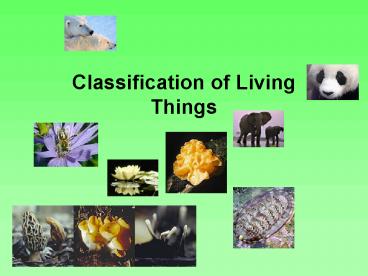Classification of Living Things - PowerPoint PPT Presentation
1 / 17
Title:
Classification of Living Things
Description:
... system was developed by Aristotle. - he grouped everything into 2 categories: plant and animal ... Taxon Corn House Fly Human. Kingdom Plantae Animalia Animalia ... – PowerPoint PPT presentation
Number of Views:1418
Avg rating:3.0/5.0
Title: Classification of Living Things
1
Classification of Living Things
2
1. Classification is a way to organize- group
things based on similarities ex cards in a
deck
2. The first classification system was
developed by Aristotle. - he grouped
everything into 2 categories plant and animal
3
3. Linnaeus developed the classification system
we use today based on the following
characteristics
1. Physical characteristics ex flowering
plants are classified based on the and
similarities of their reproductive
structures.
2. Evolutionary history (Phylogeny) ex bats
fly like birds, but their origins are
shared with animals that have hair
and feed milk to their young.
4
4. Linnaeus developed binomial nomenclature, a
system that gives each organism 2 names. These
names are always in Latin. 1. GENUS group of
closely related species CAPITALIZED
2. species specific type of organism
lower case
ex Quercus alba (White Oak)
ex Phoca vitulina (Harbor Seal)
5
5. The taxa are the groups that all living
things are divided into.
Kingdom Phylum Class Order Family
Genus species
6
Taxon Corn House Fly Human Kingdom Plantae
Animalia Animalia Phylum Anthophyta
Arthropoda Chordata Class Monocotyledon
Insecta Mammalia Order Commelinales
Diptera Primates Family Poaceae
Muscidae Hominidae Genus Zea
Musca Homo Species mays domestica sapiens
7
Biologists that study classification are
taxonomists!
The study of classification is called
taxonomy!
8
Kingdom Monera
- Found anywhere and everywhere in the world.
- Come in three basic shapes.
- Some species cause illness.
- Others are used in the food industry to make
certain foods.
- Monerans are
- Prokaryotes
- Some are autotrophic, others are heterotrophic,
and some are even chemoautotrophic - Unicellular
9
Streptococcus- some can cause strept- throat and
other illnesses.
A Bacillus one species is used to make yogurt.
Spirillum- notice the flagella which helps it
move.
10
Kingdom Protista
- Protists are
- Eukaryotic
- Some are autrotrophic and others are
heterotrophic. A few can do both. - Most are unicellular but some are multicellular.
- Algae range in size from microscopic to 20 meters
in length (kelp). - Used as food, in cosmetics, and in
pharmaceuticals. - Some species are harmful even deadly.
11
A desmid a microscopic algae.
Plasmodium a protozoan that causes malaria.
Kelp a type of brown algae.
Diatoms a protist used to make toothpaste.
12
Kingdom Fungi
- Fungi are
- Eukaryotic
- Heterotrophic
- Mostly multicellular but a few are unicellular
- Digest their food outside of their bodies and
then absorb it. - One is used in the making of most breads. Others
eat bread. - Have a cell wall made of chitin just like
insects. - Some can cause disease.
13
Yeast a fungus used to make bread, wines, and
beer.
Rhizopus a bread mold
A fungul infection commonly known as ringworm.
14
Kingdom Plantae
- Plants are
- Eukaryotic
- Autotrophic
- Multicellular
- Necessary for human survival in that they provide
a means for shelter, food, medicine,
entertainment, and of course, beauty. - Range in size from 1 cm to taller than 275
feet
15
A redwood tree and Aunt Mable and Uncle Albert.
Yummy fruits and veggies.
An orchid a flowering plant that actually
mimics their wasp pollinator.
16
Kingdom Animalia
- Animals are
- Eukaryotic
- Heterotrophic
- Multicellular
- Animals are widely diverse in where they live,
in what and how they obtain food, in how they
acquire oxygen, in how they move (if they do at
all), and of course in how they look.
17
A sea horse a type of fish.
Heartworm a parasite.
Sponge Bob and the real thing.
A cougar a deadly predator.































